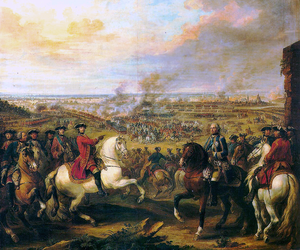
Back Batalla de Fontenoy AN معركة فونتنوي Arabic Битка при Фонтеноа Bulgarian Emgann Fontenoy Breton Batalla de Fontenoy Catalan Bitva u Fontenoy Czech Schlacht bei Fontenoy German Batalla de Fontenoy Spanish Fontenoyn taistelu Finnish Bataille de Fontenoy French
| Battle of Fontenoy | |||||||
|---|---|---|---|---|---|---|---|
| Part of the War of the Austrian Succession | |||||||
 The Battle of Fontenoy by Pierre L'Enfant | |||||||
| |||||||
| Belligerents | |||||||
|
| |||||||
| Commanders and leaders | |||||||
| |||||||
| Strength | |||||||
|
c. 50,000 men 100–110 guns [1] |
c. 50,000 men 80-101 guns [2][3] | ||||||
| Casualties and losses | |||||||
| c. 8,000 killed or wounded | c. 12,000 killed, wounded, or captured, plus 40 guns lost [4] | ||||||
The Battle of Fontenoy took place on 11 May 1745 during the War of the Austrian Succession, near Tournai, then part of the Austrian Netherlands, now in Belgium. A French army of 50,000 under Marshal Saxe defeated a Pragmatic Army[a] of roughly the same size, led by the Duke of Cumberland.
By 1745, five years of war had brought France close to financial bankruptcy, and the Austrian Netherlands seemed to offer the best opportunity for a decisive victory which would end it. In April 1745, Saxe besieged Tournai, a key strategic town on the upper Scheldt, compelling the main Allied army to march to its relief. Leaving 22,000 men to continue the siege, Saxe placed his main force about 8 kilometres (5 mi) away in the villages of Antoing, Vezon and Fontenoy, along a naturally strong feature strengthened with defensive works.
After several unsuccessful flank assaults which incurred heavy casualties, an Allied infantry column of 15,000 attacked the French centre, before being repulsed. Covered by their cavalry, they retreated toward Brussels, abandoning Tournai which fell shortly afterwards. Many British troops were withdrawn in October to suppress the Jacobite rising of 1745, leaving France in control of the Austrian Netherlands.
However, Fontenoy failed to end the war, and in May 1746, Louis XV initiated peace talks, but negotiations dragged on for the next two years. Despite further French victories at Rocoux in 1746 and Lauffeld in 1747, their economic position continued to deteriorate. The war ended in November 1748 with the Treaty of Aix-la-Chapelle, under which France relinquished its gains in the Austrian Netherlands.
- ^ McNally 2017, p. 18.
- ^ Duncan 1879, p. 127.
- ^ Skrine 1906, p. 146.
- ^ Townshend 1901, p. 69.
Cite error: There are <ref group=lower-alpha> tags or {{efn}} templates on this page, but the references will not show without a {{reflist|group=lower-alpha}} template or {{notelist}} template (see the help page).